Planning new builds - vital aspects in planning a winter sports pitch
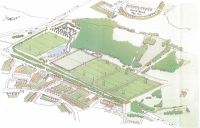
New pitches are continually in demand by clubs, colleges and institutions. The chosen location is either available farmland or exists as part of the property made available after reconfiguration of the existing layout. But there are so many hurdles to clear before there can be an active move to create the new pitch.
In judging the suitability of the land, there are a number of measurable assessments that are vital considerations - how the land falls or undulates (topography), the variation in the soil profile - particularly the nature of the topsoil - and the practical problems like access, parking facilities, proximity to buildings and traffic control. Then there are the local authority plans for future development. On top of all this, there is the inevitable interests of adjacent land owners and the politics that can ensue.

Where funds are needed, the main bodies - Sport England and the Football Foundation - are the normal sources. They require the appointment of a pitch consultant and the completion of a full assessment of the project in order to grant funds. The assessment is normally completed in the form of the following.
FEASIBILITY STUDY
1. Preparation of a design layout
Care is needed in setting out the design layout, with special consideration of run-off areas, perimeter (swale) drainage, access around the property - especially for emergencies. The siting of multiple pitches must also consider the movement of supporters and maintenance equipment - especially if sand dressings are to be imported regularly.

There is considerable difference in the preparation of pitches necessary for primary schools when comparing with clubs playing in the leagues. At primary school level, there is hardly a need to ensure overnight drainage so that play is possible the following day. Where matches cannot be cancelled, the installation of an intensive drainage system and the required maintenance programme become essential provisions. The maintenance budget must be sufficient to cope with this.
3. The intended utilisation
A natural grassed surface can only take so much wear - with adequate drainage provisions enabling a few more playing hours in the week. However, especially where community use is a pre-requisite, retaining sufficient grass cover becomes a challenge. In these instances, pitches need to retain a firmness, even if the prevention of water run-off on to the pitches and the creation of an adequate gradient are the only provisions incorporated.
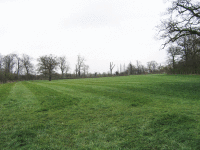
This presents actual information in the form of contours that illustrate the extent and variation in gradient throughout the property and give an accurate plan of the total area. Most important, the survey gives a good idea of the degree of earthworks needed and highlights the drainage outfall. The sheer magnitude of the earthworks involved and the drainage provisions needed to assist in an early appreciation of the overall cost of the project.
5. The soil survey
This also becomes a vital exercise, especially where relatively deep excavation is needed in the case of cut to fill development. Digging trial pits is the only way to properly assess the nature and characteristics of the different horizons. An open pit enables sound judgement to be made on the conditions to be faced in earthwork operations. In addition, limitations in deep drainage become evident and, of course, the presence - if any - of the water table. Geological maps assist here, but cannot be accurate in the assessment of the site.
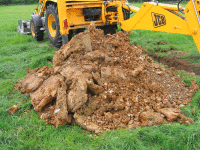
Existing plans of electricity, gas, water and foul drainage should be readily obtainable with the help of the local authority. Still there is always the possibility that pipework and cabling has been missed and contractors should always conduct electronic screening when excavating trenches.
7. Archaeological remains plans need to be examined
This can mean extended exploration before or during the project. The presence of Roman roads and building remains can severely hamper development and, in some cases, make it impossible to proceed with the construction. When approached, the local archaeological society are able to identify the possible occurrence of remains with a fair degree of accuracy.
8. Assessment of costs
In setting out the pitches on a surveyed plan, and taking into consideration a completed soil study, the estimated quantities and costs can be reasonably calculated. Provisional costs need to be considered, but current contractors rates for undertaking the work enable a realistic total cost to be estimated. At this time too, professional costs to compile working drawings and specifications, draw up a panel of selected contractors, assess tenders and over-see work through to completion and establishment can be presented.
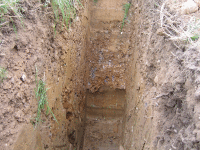
Pitches have to be properly maintained if they are to sustain the desired grass cover. Aeration, periodic fertilisation, weed control and regular mowing - properly undertaken - are essential treatments. Where a slit drain installation exists, annual sand dressings are vital to restore the openness of the slits after a heavy season of play. Funding bodies stress the need for an approved ongoing maintenance programme before awarding grants.
10. Presentation of the study highlighting options
Many potential clients do not appreciate the magnitude of costs in maintaining a football pitch. In view of the cost in creating the facility, it becomes prudent and cost-effective to carefully plan the maintenance budget. The matter of installing a slit drain system warrants serious consideration, if funds are restricted - and a realistic option is to leave it out and concentrate on ensuring no run-off water enters the pitch and a good cross-gradient of 1:50 to 1:70 is created.
PLANNING PERMISSION
Seeking planning permission can become a drawn out affair. Apart from the long term programming of local authorities, there is the possible conflict with immediately adjacent landowners. However, the main stumbling block is often access and traffic control. These investigations take much time and months and need to be put aside to resolve the situation and attain official planning permission.

The main desire is to create a playing surface without losing more than a season. There is not always a choice when to commence works.
Ideally, earthworks and primary drainage should be completed in the late summer and the grass sown in late August/early September - especially when no irrigation system is installed. If forced to commence earthworks in the autumn, there is always the probable problem of working in wet conditions and the inevitable need to discontinue works. Starting again in the spring can be fraught with setbacks where soil conditions remain very wet.
Where grass is sown in the autumn, there is good establishment well into November and grass cover should be dense enough to support play in May/June. Where slit drains are to be installed in the early summer, there is the possibility that the slits would not have grassed over by the beginning of the playing season in August - and this is essential as uncovered slits can quickly become contaminated with adjacent heavy loam topsoil. Recovery is entirely dependent on the rainfall received and rapid recovery can be achieved with special care by the contractor in compacting and narrowing back the width of the sand slit. At worst, delay in achieving cover means losing a second playing season.
IMPLEMENTING THE DESIGN
Time spent in arriving at a final design is invaluable. Management can improve the playing surface, but shortcomings in design cannot be remedied without significant upheaval and considerable expense.
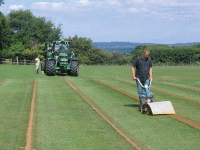
On site, all decisions are taken by the contractor and quality control is in the hands of day to day superintendence on site. Unforeseen circumstances will arise, together with the need for minor variations, and the contractor's action taken may not always be in the best interests of the client.
Under the control of a consultant, detailed working drawings should produce the design with final levels and an accurate assessment of the earthwork quantities. In addition, specifications produced, together with a schedule of quantities, ensure that selected contractors could quote for the same specified work. There is generally specific site information and the contract is managed under either the JCT or ACE General Conditions of Contract. The consultant oversees the operation and his presence at critical stages and at times of dispute and variation can prove invaluable and cost-effective. The approval of materials imported onto site, and methods undertaken, can prove far reaching in the eventual success of the development.
In addition to sound civil engineering practices, the emphasis on grading and drainage provisions become the background in the success or failure of the project.

Establishing satisfactory gradients on a pitch are vital in promoting surface water run-off. The authoritative bodies - Sport England, the Football Foundation and the Institute of Groundsmanship - are silent in prescribing minimum gradients. Secondary slit drains are not a common feature of school and local authority pitches, and it has become very evident that waterlogged conditions have arisen in puddled areas that have developed on account of minimal gradients. There is simply nowhere for surplus water to go.
It is acceptable to aim for minimum gradient between goals and create the effective gradient across the pitch. There are two options open to designers.
1. Single gradient crossfall
This is the most common design and should rely on promoting water run-off to the one side of the pitch, where it is collected in a collector drain or left to discharge to lower ground.
In cut to fill developments, this form of grading is preferable and relatively steep gradients of 1:50 are hardly noticeable with the backdrop of even modest cut slopes. Where secondary drainage is to be installed, this crossfall gradient can be reduced to 1:70. Expectedly, there must be adequate collection of water run-off from cut slopes above the pitches.

Where the existing topography is relatively level, the establishment of a camber reduces the excavation needed. In creating side slopes of 1:60 with a central convex camber, there is notable water run-off to the sides of the pitch. The installation of swale drains beyond the touchline convey this surplus water to an approved outfall.
In shedding water to the sides, the distance covered to each side is scarcely 35m and the significant cross gradient to each side ensures, too, that puddles are not formed. This form of grading the pitch, in shedding surface water rapidly, makes it less necessary to install secondary drainage - especially on school and lower level pitches in local authorities.
Drainage

Where cancellation of matches due to waterlogged conditions is not acceptable, the only option is to firstly ensure there are consistent satisfactory gradients and then install close-spaced slit drains that are properly maintained - especially with the annual application of sand dressing.
Gordon Jaaback, Agronomist & Project Manager
Email: gordonjbk@turfandgrass.com
Website: www.turfandgrass.com
